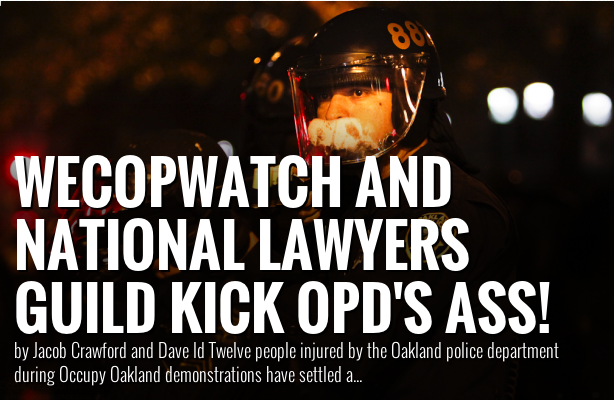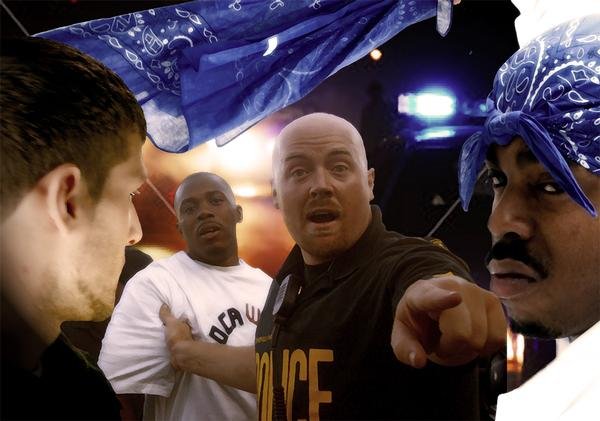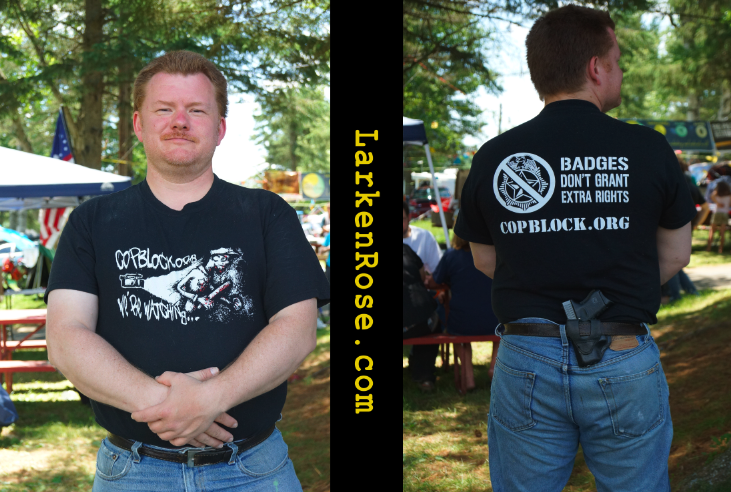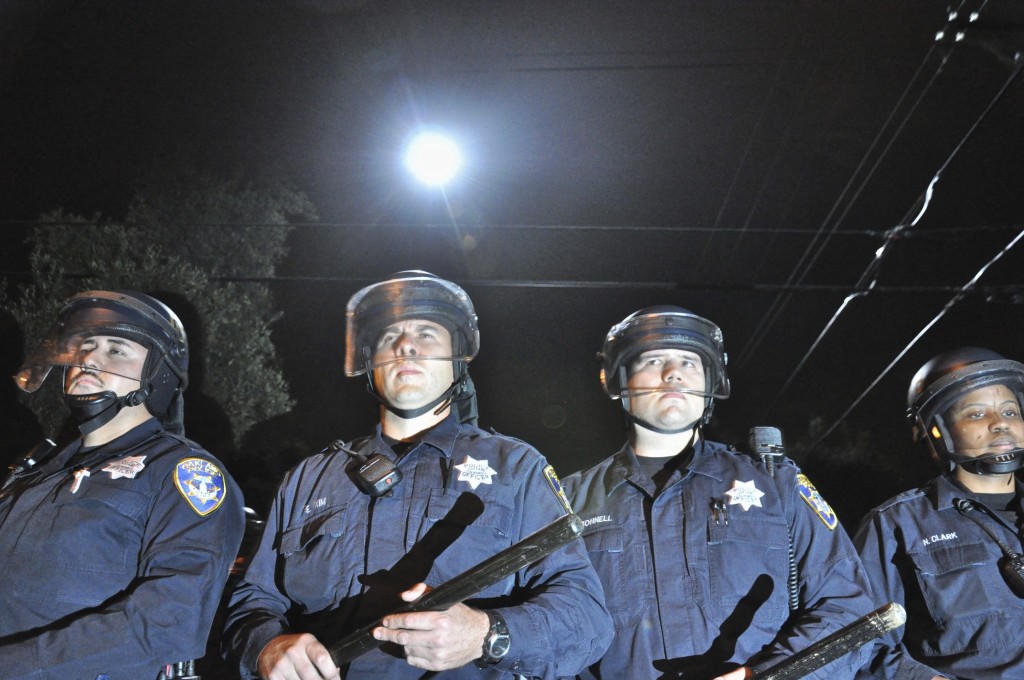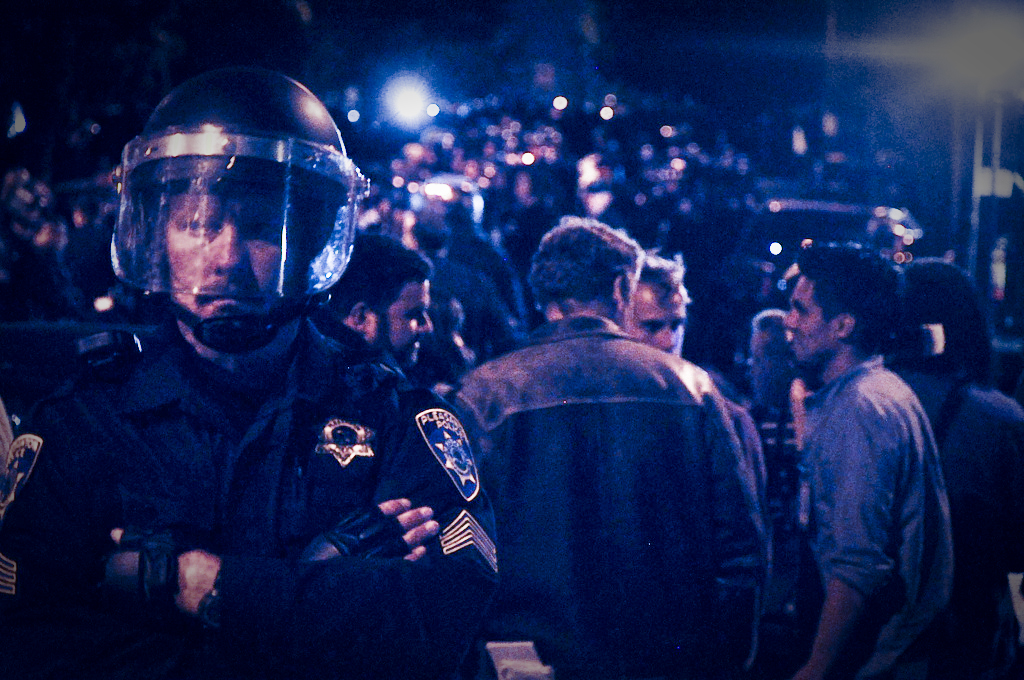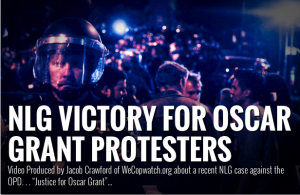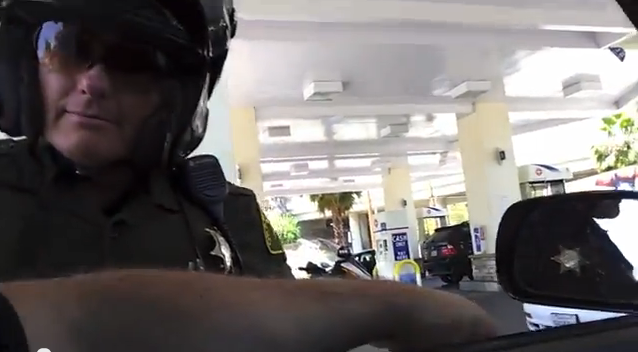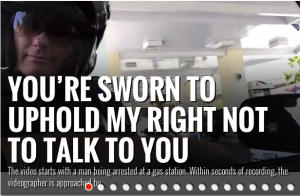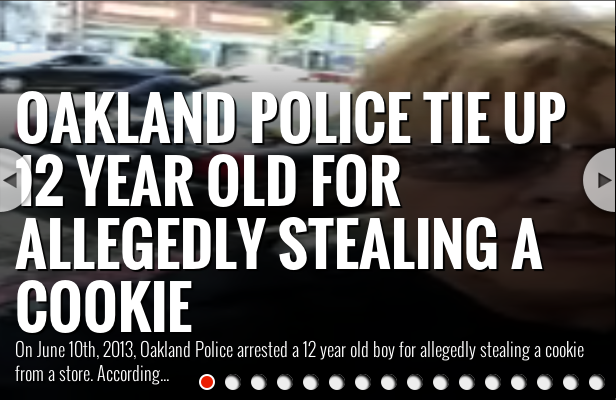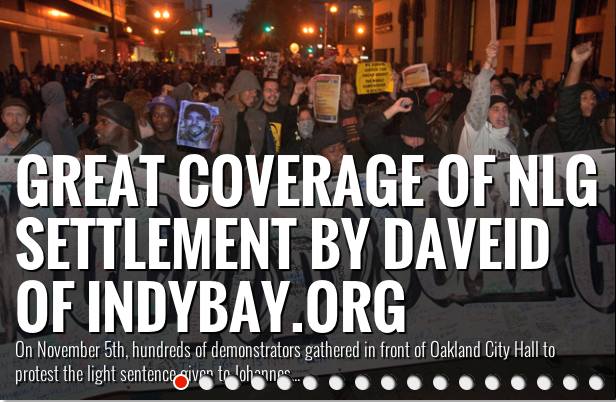
On November 5th, 2010, hundreds of demonstrators gathered in front of Oakland City Hall to protest the light sentence given to Johannes Mehserle for killing Oscar Grant by shooting him in the back in front of hundreds of witnesses. As evening fell, marchers took to the streets and headed toward the Fruitvale BART station, the scene of the shooting on January 1, 2009. Oakland police, however, had other plans. One hundred and fifty demonstrators were detained and arrested, forced to spend up to twenty-four hours in police custody under inhumane conditions. As no one arrested was ever even charged, the arrests and jailing amounted to illegal extrajudicial punishment of protesters for merely exercising their right to free speech and protest police brutality. In a class action settlement between arrestees and the City of Oakland announced today by the National Lawyers Guild, the city has not only acknowledged that the arrests were illegal but has agreed to pay $1.025 million in compensation to the plaintiffs and their attorneys. Additionally, Oakland police have given their consent to abide by a revised crowd control policy meant to avoid such unnecessary harm to protesters in the future and to have their adherence to the policy overseen by the court for a period of up to seven years. The NLG rightfully calls the settlement an "important victory for democracy."
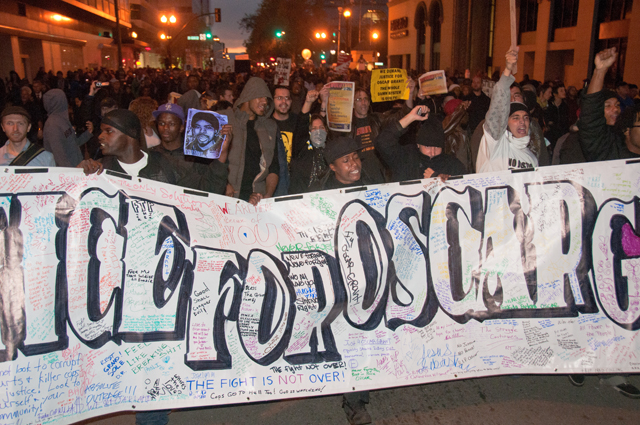
[Photo of November 5th march on 14th Street, just east of Broadway, by Felix Barrett]
Just last week the Grand Lake Theater rolled out the red carpet for the Oakland premiere of the highly anticipated and award winning new film "Fruitvale Station," which documents the last day in the life of Hayward resident Oscar Grant before BART police officer Johannes Mehserle shot him in the back. In attendance were the movie’s stars such as Octavia Spencer and Michael B. Jordan, director Ryan Coogler, and producer Forest Whitaker. It was a private screening, however, as the film doesn’t officially open to the public nationwide until July 12th.
Unfortunately, leaders of the Oscar Grant Foundation were largely placed in charge of deciding who else besides the cast and crew would be invited to the premiere and they chose to invite a wide array of establishment leaders including Mayor Quan and the entire city council, even BART’s new chief of police, Kenton Rainey, and and array of corporate media rather than predominantly those who had been on the front lines of the struggle for justice for Oscar Grant such as Oscar Grant’s closest friends, community activists, and independent journalists. Despite the fact that the invitation list left dozens of open seats in the theater, Oscar Grant’s friends who were on the Fruitvale station platform with him when he was killed were not originally invited. Neither were their families. Neither were most of organizers and community activists who fought long and hard for justice for Oscar Grant. It took deliberate behind the scenes advocacy to get Oscar Grant’s friends into the show and a community activist or two managed to successfully insist at the doors of the theater that they be allowed to view the screening.
And yet, if any justice was achieved for Oscar Grant, through the first-of-its-kind-in-California felony manslaughter conviction of Mehserle, police reform efforts at BART, or the early retirements of disgraced figures such as BART police chief Gary Gee and Alameda County District Attorney Tom Orloff, it was community activists and not city leaders who made that happen. With the exception of a few council members who had their moments at times standing up for justice — such as Jean Quan and Rebecca Kaplan, who once attempted to prevent police violence against protesters in the streets only to later incur the wrath of OPD themselves, or Desley Brooks, who alternated between adamantly calling out the misdeeds of BART police and refusing to allow the voices of Oakland’s youth to be heard on the matter — city leaders largely worked against the movement for justice for Oscar Grant.
Nevertheless, with today’s announcement of a settlement in the Spalding vs. The City of Oakland class action lawsuit, up to 150 community activists, protesters, and legal observers will soon get their comeuppance for abuses dished out by the Oakland police and Alameda County sheriff’s departments on the night of Mehserle’s sentencing. One hundred and fifty two people were illegally corralled, or "kettled," and arrested by Oakland police on November 5, 2010, but two were charged with individual offenses (both of which allegedly occurred after the kettling) and are not a part of the class definition. Each of those arrested for "unlawful assembly" but never charged — granted they submit a claim form with the National Lawyers Guild by August 5, 2013 (see PDFs here) — is entitled to approximately $4,500 as compensation for their illegal arrest by Oakland police that night and the degradations they suffered while in the Alameda county sheriff’s custody at Santa Rita jail.
It was ironic that Oakland police had chosen that night to kettle and arrest so many people. Organizers of the daytime vigil and rally had gone out of their way to seek city permits for the event, when most justice for Oscar Grant protests had defiantly been organized without seeking the consent of city officials. Organizers had even worked with city leaders and police on arranging a route for the march that was to follow the rally in front of City Hall in Frank Ogawa plaza, now commonly referred to as Oscar Grant plaza. Organizers submitted plans for a march route to Defremery (or LIttle Bobby Hutton) Park in West Oakland. OPD originally approved the route, then demanded an alternate route, seeming to object to a march all together. Organizers eventually cancelled plans for a city-approved march, leaving it to those in attendance in the plaza to decide what they should do after the rally, even though it was common knowledge that demonstrators would most likely want to march in protest of Mehserle’s light sentence.
It was especially ironic that the night Oakland police chose to arrest the largest number of people at any Oscar Grant demonstration ever would be the one where there was little to no property destruction, save for temporary construction fencing surrounding the abandoned Henry J. Kaiser convention center which wasn’t actually destroyed, just pushed to over allowing marchers to continue southeast toward the Fruitvale BART station when police first attempted a kettle on 10th Street. There were also reports of a small handful of car windows being damaged. But, compared with the countless smashed storefronts and multiple cars set afire or the hundreds of pairs of Nike shoes liberated from a Foot Locker outlet at previous Oscar Grant rebellions, pushing over a fence and possibly breaking some windows was relatively mild. Besides, arresting and sending to jail 150 people for the actions of a few is clearly overbroad and unjust.
It was not surprising, though, that Oakland police chose to kettle and arrest so many people that night. City leaders had long grown weary of huge numbers of people publicly, and often angrily, demanding an end to police violence against people of color. Then-chief Anthony Batts had made numerous statements about the protests needing to stop, that there did not need to be one at each and every milestone during the trial of Johannes Mehserle. And so he and the Oakland police department set out to do just that on November 5, 2010, to stop the protests cold, by any means necessary. There was the first attempt at a kettle on 10th Street between the Henry J building and Laney College as marchers merely walked down the darkened street. With nothing major to point to in order to justify the mass arrests, the official excuse for the actual kettling on 6th Avenue came over the corporate media wires shortly thereafter, that a protester had grabbed a police officer’s gun and holster as chief Batts claimed at a press conference that night. But the snatching of a gun never actually happened, as Batts knew at the time. Instead what really happened was an officer Keith Geiger’s holster broke as he tackled a protester, so the gun-grab ruse was quickly dropped by OPD the following day, although the damage had already been done as the corporate media reported the initial gun grab remarks by Batts but never followed up with questions about the claims later.
And so, while there was never a dispersal order from police as is required by OPD’s own crowd control policy, demonstrators were trapped on 6th Avenue between 17th and 18th Streets by hundreds of police officers. A few lucky ones managed to escape the kettle by jumping residential fences, but others who attempted to do so were nabbed and roughed up by police who were waiting on side streets. From there it only got worse. Media were allowed to leave the kettle, but not legal observers such as class representative Dan Spalding. Those left behind remained for hours on the street as police handcuffed them and placed them into vans and buses for transport to Santa Rita jail. The arrests were purportedly for "unlawful assembly," but according to California law, most misdemeanors are to be treated as "cite and release" offenses — and in fact no charges were actually ever filed against any of those arrested that night.
In effect, the arrests were illegal extrajudicial punishment enforced by the Oakland police and Alameda County sheriff’s departments at the behest of city leaders. Those arrested spent well over an hour waiting to be transported, hours more waiting in the buses in front of Santa Rita while they were processed into the jail, and during this entire time everyone was denied access to use of rest rooms and medical treatment that might be required. Conditions in the jail were so cramped that most arrestees did not even have the space to lie down on the floor throughout the night. Women were further degraded by being forced to take pregnancy tests (a broader issue that was not resolved in the Spalding case, but as a result of new sheriff’s procedures being instituted for mass arrests, women who are arrested in a mass arrests will not be pregnancy tested). Food was not provided for up to twelve hours. And it was roughly twenty-four hours before the last arrestee was released. All for an "offense" that was never even charged and, even if it was, protesters should have been issued a citation and promptly released.
More importantly perhaps on a broader scale than the monetary compensation for those arrested, though, looking forward at least, is that the National Lawyers Guild has again legally bound the Oakland police department to its own crowd control policy, this time with the added security of court enforcement should future violations occur. The most recent crowd control policy was the result of a previous civil suit brought against OPD by the NLG over the police attack against anti-war demonstrators at the Port of Oakland in 2003. One of the largest issues tackled when the policy was finalized in 2005 and agreed to by all parties, including OPD, was OPD’s use of projectile weapons against non-violent demonstrators; OPD had caused serious injuries by firing wooden dowels and beanbags at the heads of protesters on April 7, 2003. (More recently, violations of this section of the policy were blatantly disregarded during the Occupy Oakland demonstrations when, for instance, a bean bag was fired close-range at Scott Olsen’s face, a bean bag was shot at Scott Campbell‘s groin area, and countless non-violent others were hit all over with pepper balls and other projectiles and offensive weaponry.)
As for the Spalding settlement, one of the most relevant sections of the 2005 crowd control policy regards when an unlawful assembly may be declared and the guidelines for declaring one. Quite clearly, the policy reads: "The mere failure to obtain a permit, such as a parade permit or sound permit, is not a sufficient basis to declare an unlawful assembly. There must be criminal activity or a clear and present danger of imminent violence (pg 11)." There was no clear and present danger as the marchers walked down 10th Street into the first attempted kettle or 6th Avenue into the final one. The policy continues: "When the only violation present is unlawful assembly, the crowd should be given an opportunity to disperse rather than face arrest." This absolutely did not happen on November 5. The goal obviously was to end the demonstration, period, rather than deter or break-up some sort of threatening or illegal behavior. And throughout the history of the Movement for Justice for Oscar Grant, if any property destruction did occur, it was downtown, not in East Oakland on the way to or from the Fruitvale station, as marchers were clearly headed on November 5.
The most significant aspects of the injunctive relief in the Spalding case may very well be twofold. The revised section of crowd control policy should go a long way towards relieving OPD of their nasty habit of arresting demonstrators on bogus charges that will never be filed by the District Attorney, just to let protesters accused of no specific felonious crime languish in jail for as many days as possible. The specific section that was updated, on "CITE AND RELEASE PROCEDURE (pg 18)," has been made substantially more clear, specifying the handful of reasons that a protester cited with a misdemeanor is *not* to be released. Otherwise, those generally expressing their free speech rights should not be booked into jail, ever. And, as stated in the existing policy, "Individuals may not be arrested based on their association with a crowd in which unlawful activity has occurred. There must be probable cause for each individual arrest (pg 16)." And now, OPD’s crowd control policy comes with court enforcement for a period of up to seven years, which can be extended if OPD is not living up to their own policies. Furthemore, there is a comprehensive crowd control policy revision process currently happening, in which OPD and the Compliance Director are meeting and conferring with the NLG , ACLU, and attorney Jim Chanin, as the Spalding settlement requires. It’s almost hard to imagine what the National Lawyers Guild has been able to achieve here. If it can be implemented as agreed upon, and enforced by the court, a great deal of unnecessary suffering normally inflicted by OPD upon protesters can be avoided.
Sadly, looking back, and other factors may have played a role, but there were no large demos for Oscar Grant after the November 5 kettle, nor for any Oakland police murder since that time, although the movement for justice for Alan Blueford has certainly kicked up some dust at city council meetings and elsewhere. Without a doubt, free speech was definitely stifled by police actions on November 5, 2010. Cynics might say that the large financial settlement in the Spalding case is the price that the city is willing to pay in order to quash large scale dissent over police brutality, the cost of business as usual in Oakland. The city has certainly paid out millions of dollars in dozens of other individual and class action cases involving police corruption, brutality, and killings — yet the police violence and financial settlements continue. More than likely, the city similarly will pay dearly for the more recent police abuses committed during the time of Occupy Oakland, including for the much larger kettling of over four hundred people in front of the downtown YMCA on January 28, 2012, and for the countless physical injuries inflicted on protesters and independent journalists on October 25 and November 2, 2011, and other days.
Oakland police more or less did the same thing to the anti-war movement in 2003 as it did to the justice for Oscar Grant movement in 2009-2010 and the Occupy movement in 2011-2012. It remains to be seen if there have been or will be any real lessons learned by Oakland police and city leaders — if they indeed feel the pain of local taxpayers continually having to compensate the seemingly never-ending list of OPD’s victims — or if the next large protest movement will be just another in a long line of social justice movements to suffer illegal abuses at the hands of Oakland police, with a nod and a wink, and sometimes open cheering, from the pusillanimous elected democrats who supposedly run this town.
One thing you can count on, though, is that the National Lawyers Guild is watching the police, intently, and will continue to fight for the people’s right to assemble and demonstrate against injustices without unconstitutional state repression. The NLG deserves the support of everyone who cares about social justice in this country.
NLG press release and related documents:
National Lawyers Guild (NLG) Obtains $1M, OPD and Sheriff Reforms For Oscar Grant Protesters
http://www.indybay.org/newsitems/2013/06/24/18738864.php
Excellent video by Jacob Crawford with plaintiff interviews and police radio audio about not giving dispersal order:
NLG Victory for Oscar Grant Protesters - Video
http://www.indybay.org/newsitems/2013/06/24/18738871.php
related Indybay features:
Johannes Mehserle Gets Minimum Sentence of Two Years
Community Gathers in Oakland to React to Mehserle Sentencing; 152 Arrested in Night March
http://www.indybay.org/newsitems/2010/11/05/18663245.php
NLG Files Lawsuit Against Oakland Police
Class Action Lawsuit Asserts Constitutional Violations at Oscar Grant Demonstrations
http://www.indybay.org/newsitems/2011/06/14/18681925.php
Complete Indybay Coverage of the Justice for Oscar Grant Movement
